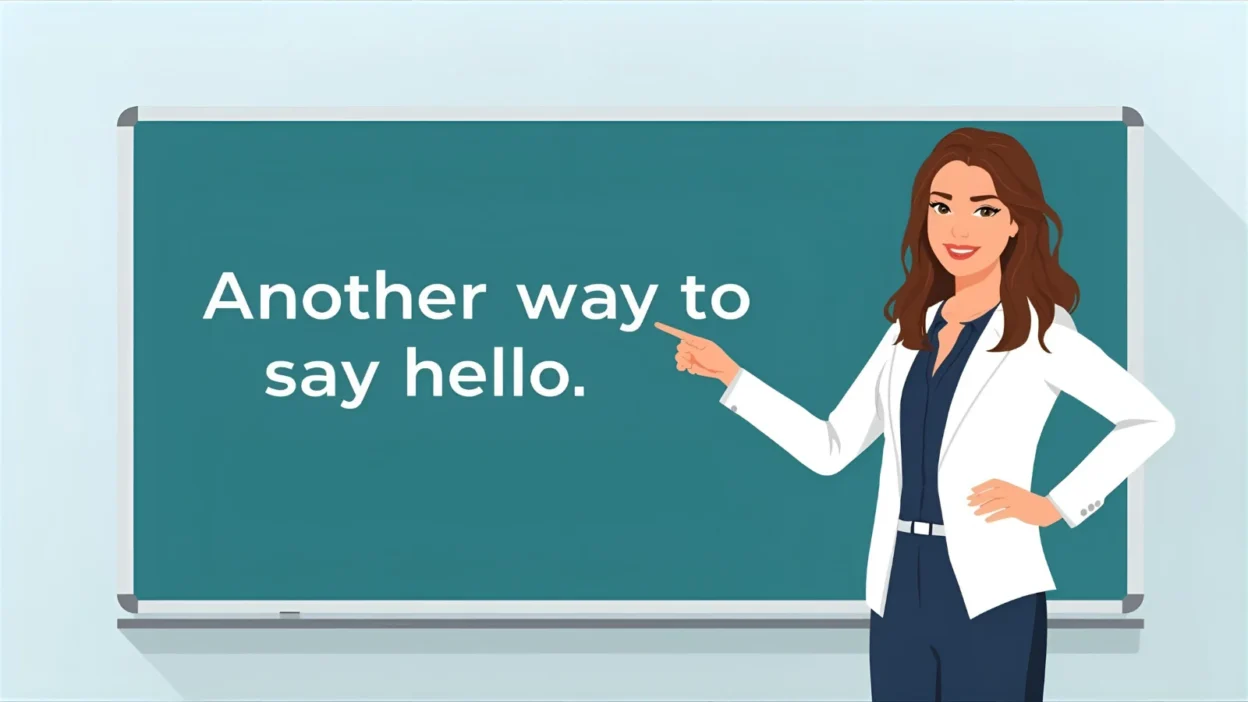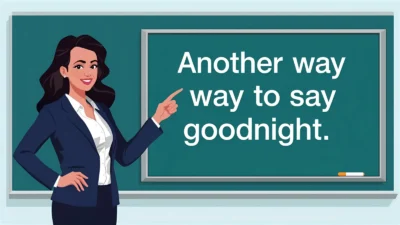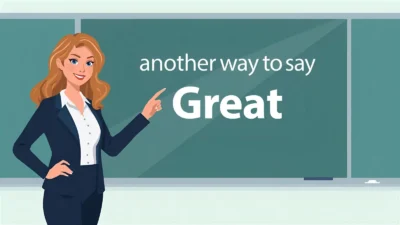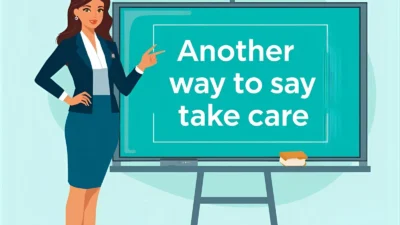The word “Hello” is one of the most recognizable greetings in the world. It’s simple, friendly, and universal — used in nearly every form of communication, from casual conversations to business emails.
However, depending on the situation, tone, and relationship with your audience, using “hello” every time can feel repetitive or too plain. Whether you’re writing an email, greeting a client, meeting someone new, or sending a message to a friend, choosing a different greeting can help you set the right mood — warm, polite, enthusiastic, or professional.
Here are 36 alternative ways to say “hello,” complete with meanings, explanations, real-life examples, best contexts, and tone descriptions.
1. Hi
Meaning: A friendly, informal greeting.
Detailed Explanation: The most common alternative to “hello.” It’s short, cheerful, and works in nearly all casual situations.
Scenario Example: Hi, it’s great to see you again!
Best Use: Everyday speech, informal emails, friendly messages.
Tone: Warm, casual, approachable.
2. Hey
Meaning: A relaxed and modern way to greet someone.
Detailed Explanation: Often used between friends or colleagues; conveys friendliness and energy.
Scenario Example: Hey! How’s your day going?
Best Use: Informal chats, texts, or social media.
Tone: Casual, friendly, upbeat.
3. Good Morning
Meaning: A time-specific greeting used before noon.
Detailed Explanation: A polite, professional greeting that sets a positive tone.
Scenario Example: Good morning, everyone. Let’s get started with today’s meeting.
Best Use: Professional emails, workplace settings.
Tone: Polite, professional, cheerful.
4. Good Afternoon
Meaning: Greeting used after noon and before evening.
Detailed Explanation: Slightly formal, ideal for business or customer-facing interactions.
Scenario Example: Good afternoon! How can I assist you today?
Best Use: Customer service, business communication.
Tone: Courteous, professional.
5. Good Evening
Meaning: A polite greeting used later in the day.
Detailed Explanation: Works well in both formal and semi-formal situations.
Scenario Example: Good evening, everyone. Thank you for joining us.
Best Use: Events, speeches, or formal correspondence.
Tone: Elegant, formal, respectful.
6. Greetings
Meaning: A formal and traditional way to say hello.
Detailed Explanation: Works best in written or ceremonial contexts.
Scenario Example: Greetings! We are pleased to welcome you to the annual conference.
Best Use: Letters, speeches, or formal announcements.
Tone: Formal, respectful.
7. Hi There
Meaning: A friendly and slightly informal version of “hi.”
Detailed Explanation: Softer and more engaging, often used in customer-facing emails.
Scenario Example: Hi there! Thanks for reaching out to our support team.
Best Use: Customer emails, friendly communication.
Tone: Warm, approachable, semi-formal.
8. Hey There
Meaning: A casual and inviting greeting.
Detailed Explanation: Conveys friendliness and ease; less formal than “hi there.”
Scenario Example: Hey there! Long time no see.
Best Use: Informal chats, texts, or friendly emails.
Tone: Casual, energetic, personable.
9. What’s Up?
Meaning: A relaxed way to ask how someone is doing.
Detailed Explanation: Common in spoken English; conveys familiarity.
Scenario Example: Hey, what’s up? How’ve you been?
Best Use: Friends, casual conversations.
Tone: Informal, friendly, conversational.
10. How’s It Going?
Meaning: A casual greeting that asks about the person’s well-being.
Detailed Explanation: Works as both a hello and a light conversation starter.
Scenario Example: Hi! How’s it going today?
Best Use: Social conversations, casual workplaces.
Tone: Friendly, natural, conversational.
11. Howdy
Meaning: Informal, regional greeting (popular in the U.S. South and West).
Detailed Explanation: Playful and relaxed, often used humorously.
Scenario Example: Howdy, partner! Ready for the meeting?
Best Use: Informal, humorous, or regional settings.
Tone: Friendly, informal, folksy.
12. Welcome
Meaning: Used to greet someone arriving at a place or event.
Detailed Explanation: Warm and polite; conveys hospitality and inclusion.
Scenario Example: Welcome! We’re so glad you could join us today.
Best Use: Events, speeches, or customer service.
Tone: Polite, friendly, inviting.
13. Pleasure to Meet You
Meaning: A formal greeting when meeting someone for the first time.
Detailed Explanation: Perfect for professional introductions.
Scenario Example: Hello, I’m Sarah — pleasure to meet you.
Best Use: Networking, interviews, professional meetings.
Tone: Courteous, formal.
14. Nice to See You
Meaning: Used when meeting someone you already know.
Detailed Explanation: Shows warmth and appreciation for reconnecting.
Scenario Example: Hi Mark, nice to see you again!
Best Use: Casual or professional meet-ups.
Tone: Friendly, polite, genuine.
15. Long Time No See
Meaning: Used when greeting someone after a long absence.
Detailed Explanation: Friendly and slightly playful; implies familiarity.
Scenario Example: Hey! Long time no see — how have you been?
Best Use: Personal conversations, casual emails.
Tone: Warm, informal, nostalgic.
16. How Are You?
Meaning: A classic greeting that also shows care.
Detailed Explanation: Suitable for almost any situation — formal or casual.
Scenario Example: Hello, how are you today?
Best Use: Business and personal interactions alike.
Tone: Neutral, courteous, versatile.
17. Yo
Meaning: A very casual and modern greeting.
Detailed Explanation: Informal and energetic, often used among close friends.
Scenario Example: Yo! What’s going on?
Best Use: Friendly, youthful interactions.
Tone: Fun, urban, relaxed.
18. Salutations
Meaning: A highly formal or literary greeting.
Detailed Explanation: Often used for humor or dramatic effect today.
Scenario Example: Salutations, colleagues. Let’s begin today’s discussion.
Best Use: Writing, speeches, or stylized communication.
Tone: Formal, refined, old-fashioned.
19. Hi Everyone
Meaning: Group version of “hello.”
Detailed Explanation: Great for addressing multiple people in one message.
Scenario Example: Hi everyone, welcome to our weekly update meeting.
Best Use: Emails, presentations, group chats.
Tone: Inclusive, warm, semi-formal.
20. Hi All
Meaning: A friendly and efficient group greeting.
Detailed Explanation: Common in professional emails; less formal than “Dear all.”
Scenario Example: Hi all, just a quick reminder about tomorrow’s deadline.
Best Use: Work emails, announcements.
Tone: Polite, professional, friendly.
21. Dear [Name]
Meaning: A formal way to open written correspondence.
Detailed Explanation: Common in letters or formal emails; respectful and professional.
Scenario Example: Dear Mr. Khan, I hope this message finds you well.
Best Use: Business emails, letters, official documents.
Tone: Formal, polite, professional.
22. Good Day
Meaning: A polite and traditional greeting used any time of day.
Detailed Explanation: Sounds refined and slightly formal, often used in writing.
Scenario Example: Good day! I wanted to follow up on your recent inquiry.
Best Use: Formal communication, customer interactions.
Tone: Courteous, formal, timeless.
23. Hi Friend
Meaning: A warm and affectionate greeting.
Detailed Explanation: Expresses closeness and friendliness in informal contexts.
Scenario Example: Hi friend! How are you holding up?
Best Use: Texts, casual emails, social media.
Tone: Warm, personal, cheerful.
24. Hey Everyone
Meaning: A casual, energetic greeting for groups.
Detailed Explanation: Great for opening speeches or team chats.
Scenario Example: Hey everyone! Excited to see you all here today.
Best Use: Informal meetings, friendly gatherings.
Tone: Enthusiastic, inclusive.
25. Top of the Morning
Meaning: A cheerful, traditional Irish greeting.
Detailed Explanation: Rarely used today except humorously or affectionately.
Scenario Example: Top of the morning to you! Ready for a great day?
Best Use: Lighthearted, cultural, or playful communication.
Tone: Cheerful, old-fashioned, friendly.
Conclusion
The word “Hello” may be universal, but your greeting can be customized to reflect tone, setting, and personality. In formal contexts, choose phrases like “Good morning” or “Greetings.” For casual settings, go with “Hey,” “Hi there,” or “What’s up?”
Your greeting sets the first impression — whether it’s professional warmth, friendly energy, or approachable charm. Experiment with these 25 alternatives to make every “hello” feel natural, genuine, and perfectly suited to the moment.



